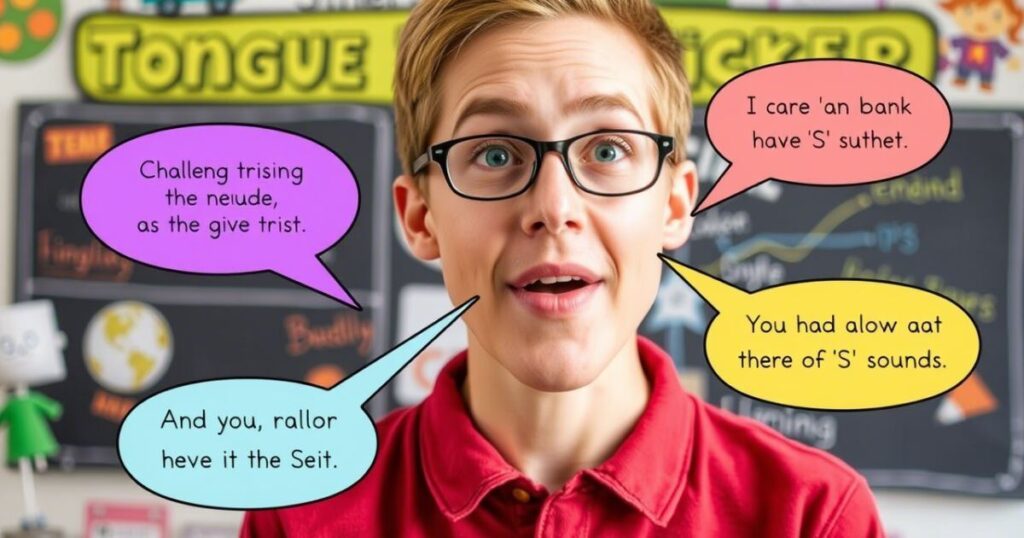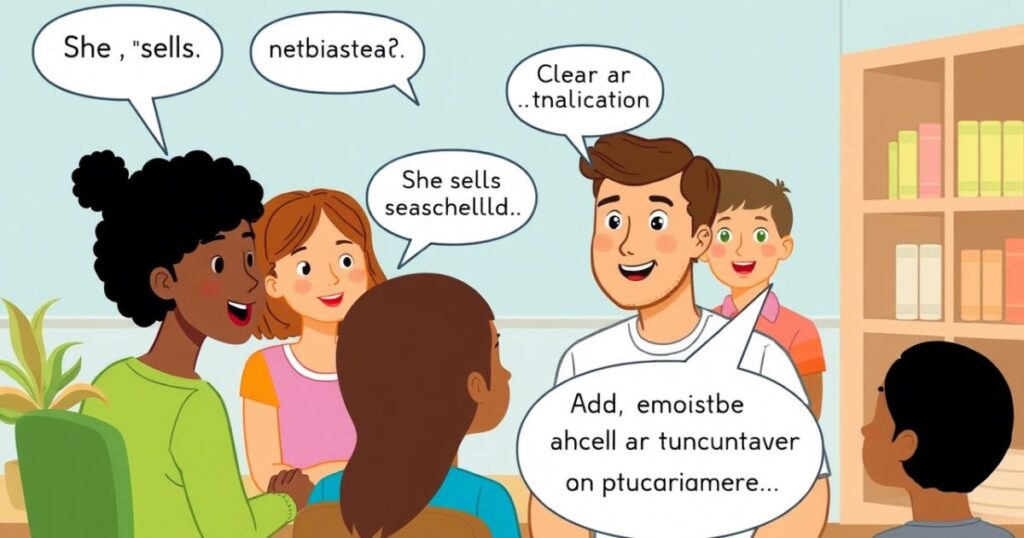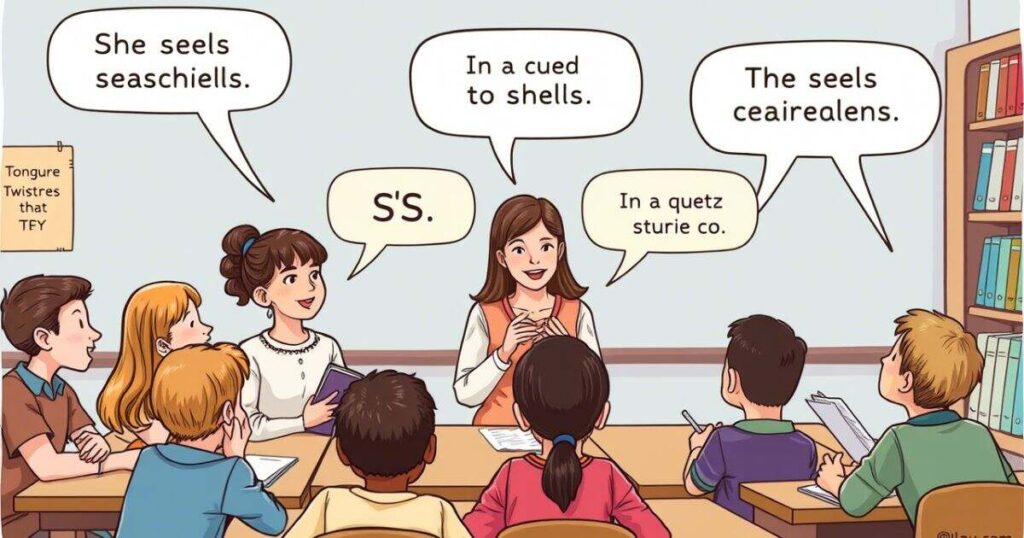S Tongue Twisters are a fun way to improve pronunciation and speaking skills. They help people practice tricky S sounds and speak more clearly. Many learners use tongue twisters with S to train their mouths and tongues to move faster and smoother. Saying a tongue twister with S over and over makes speech more natural.
S Tongue Twisters are also great for speech therapy. Many experts use S tongue twisters speech therapy exercises to help with speech difficulties. Repeating a tricky S tongue twister can strengthen the muscles used for speaking. Whether you’re a student, a teacher, or someone improving pronunciation, these fun challenges can help. Try different S tongue twisters and see how fast you can say them! With regular practice, your speech will become clearer and more confident.
Here are a few tongue twisters focused on the letter ‘S’:
These tongue twisters are packed with “S” sounds, making them a great warm-up exercise for improving pronunciation:
- She sells seashells by the seashore.
- Sam’s shop stocks short spotted socks.
- Six slippery snails slid slowly seaward.
- Some shivering snakes silently slither south.
- Susie sat sewing seven silky satin skirts.
- Sarah saw seven silver swans swimming southward.
Try saying these tongue twisters slowly at first, focusing on clarity, then increase your speed as you improve!
Here are some popular tongue twisters involving the letter “S”
The letter “S” can be tricky when it appears multiple times in a sentence. Here are some popular tongue twisters to challenge your speech skills:
- Silly sheep sip sweet sugar syrup on Sundays.
- Seven slippery seals slid southward swiftly.
- Sassy Sally swiftly saw seven slippery seals.
- Six sneaky squirrels scampered south.
- Some smug slugs snuck south silently.
- She sells seashells by the seashore.
- Sally sells seashells by the seashore.
- Silly Sammy swiftly shooed seven silly sheep.
- Six slippery snails slid slowly seaward.
- Susie works in a shoeshine shop. Where she shines, she sits, and where she sits, she shines.
- Swan swam over the sea, Swim, swan, swim! Swan swam back again, Well swum, swan!
Each of these tongue twisters tests your ability to pronounce “S” correctly while maintaining fluency.
What is the tongue twister with a lot of S?

A tongue twister that contains an excessive number of “S” sounds is:
“She sells seashells by the seashore. The seashells she sells are surely seashells. So if she sells shells on the seashore, I’m sure she sells seashore shells.”
This is one of the most well-known S tongue twisters, and it’s perfect for improving articulation and diction.
What tongue twisters make you say the S word?
Some tongue twisters naturally force you to repeat the letter “S” rapidly, increasing the chance of a slip-up:
- Six slippery snails slid south silently.
- Seven sneaky snakes slither south.
- Some slippery sausages sizzled in a skillet.
The rapid repetition of “S” sounds can cause pronunciation challenges, making these great for practice!
What is the hardest tongue twister?
One of the most difficult tongue twisters in English is:
“The sixth sick sheik’s sixth sheep’s sick.”
This tongue twister is particularly challenging due to the combination of “S” and “SH” sounds, making it difficult to say quickly and correctly.
Another difficult one is:
“She sells sea shells by the seashore, but if the sea shells she sells are surely sea shells, then I’m sure she sells seashore shells.”
Mastering this one takes time and patience!
What are tongue twisters with Z and S?
Tongue twisters with both “Z” and “S” sounds add another level of difficulty:
- Zany zebras zigzag swiftly, slipping southward.
- Zebras and seals zoomed south in zigzags.
- Zippy zebras zoom south, singing silly songs.
Practicing these can help you differentiate between “Z” and “S” sounds while improving fluency.
What are 10 tongue twisters?
Here are ten fun tongue twisters to challenge yourself with:
- She sells seashells by the seashore.
- Six slippery snails slid south silently.
- Sally swiftly saw seven slippery seals.
- Some smug slugs snuck south.
- Susie sits sewing silk suspenders.
- Seven slick sailors sailed the seven seas.
- Silly sheep sip sweet sugar syrup.
- Sandy’s striped socks slipped silently.
- The sixth sick sheik’s sixth sheep’s sick.
- Zigzagging zebras zoomed zestfully south.
Try to say each one five times in a row without making a mistake!
S tongue twisters speech therapy
Tongue twisters are widely used in speech therapy to help individuals improve articulation, diction, and control over specific sounds. The “S” sound can be difficult for those with speech impediments, making S tongue twisters a valuable exercise.
Speech therapists recommend tongue twisters to:
- Strengthen the muscles involved in speech.
- Improve pronunciation clarity.
- Reduce lisps or unclear speech patterns.
- Help individuals with speech delays or disorders.
How do tongue twisters challenge pronunciation skills?
Tongue twisters force your mouth and tongue to work quickly and accurately, improving:
- Diction : Speaking clearly and distinctly.
- Articulation : Pronouncing each sound correctly.
- Fluency : Speaking smoothly without hesitation.
Regular practice can enhance speech precision and make communication clearer.
How can tongue twisters benefit individuals with speech impediments?
For individuals with speech difficulties, tongue twisters provide a structured and fun way to:
- Strengthen vocal muscles.
- Reduce stuttering or lisping.
- Improve pronunciation through repetitive practice.
- Boost confidence in speaking.
What are some examples of tongue twisters that can be helpful for individuals with speech impairments?
Here are some simple and effective tongue twisters for speech therapy:
1.Walter walked with Wendy, wondering why Wally was whistling.
(Targets ‘W’ sounds)
2.Fuzzy Wuzzy was a bear. Fuzzy Wuzzy had no hair. Fuzzy Wuzzy wasn’t very fuzzy, was he?
(Targets ‘F’ sounds)
3.Charlie chose cheesy chili for lunch.
(Targets ‘CH’ sound)
4.Larry’s lazy lizard lounged lazily in the sunny sand.
(Targets ‘L’ sounds)
5.Tommy takes ten tiny turtles to the terrific town.
(Targets ‘T’ sounds)
Tailor the tongue twisters to focus on the specific sounds that need improvement. Consistent practice can be beneficial in speech therapy.
These tongue twisters focus on S sounds while keeping the words easy to pronounce.
How often should individuals with speech impediments practice tongue twisters to see improvement?
Experts recommend practicing tongue twisters for at least 10: 15 minutes daily to see significant progress in speech clarity.
- Start slowly, ensuring proper pronunciation.
- Gradually increase speed while maintaining clarity.
- Repeat the same tongue twister multiple times before switching to another.
Related Guide:
Openned Or Opened: Spelling + Examples [2025]
Are there any potential drawbacks or limitations to using tongue twisters as a speech therapy tool?
While tongue twisters are beneficial, they do have limitations:
- They may frustrate individuals with severe speech difficulties.
- Some people may require additional therapy techniques for specific speech disorders.
- Without guidance, incorrect pronunciation may become a habit.
Using tongue twisters alongside professional speech therapy can be the most effective approach.
Can tongue twisters help improve communication skills in multiple languages?
Yes! Tongue twisters exist in nearly every language and can:
- Improve pronunciation in a foreign language.
- Strengthen muscle control for clear speech.
- Help speakers master difficult sounds in their target language.
For example, in Spanish, a classic tongue twister is:
- “Tres tristes tigres tragan trigo en un trigal.”
- This helps Spanish learners master rolling their R’s and pronunciation speed!
How do S tongue twisters help in accent reduction?

S tongue twisters are a fantastic tool for refining pronunciation and reducing accents. When people speak quickly, their native accent can interfere with clear articulation. Practicing tongue twisters with “S” sounds forces the mouth, tongue, and vocal cords to work in unison, strengthening muscle memory. For example, repeating “She sells seashells by the seashore” helps non-native speakers master the soft “S” sound while improving their fluency. Over time, this repetition retrains the speech muscles, making pronunciation more natural and precise.
Additionally, speech therapists often use tongue twisters to help individuals minimize strong regional or foreign accents. By focusing on specific phonetic challenges, speakers gain better control over their vocal delivery. Whether you’re learning English or refining your professional speaking voice, consistent practice with S tongue twisters can smooth out speech patterns and enhance clarity.
Can S tongue twisters improve public speaking skills?
Absolutely! Public speaking is all about clear articulation, confidence, and rhythm, and S tongue twisters can sharpen all three. Many speakers struggle with tongue slips, mumbling, or rushing through words. By practicing sentences like “Six slippery snails slid slowly south”, speakers train their mouths to enunciate words crisply. This not only reduces verbal stumbling but also boosts speaking speed and control.
Beyond articulation, tongue twisters improve breathing control. Public speakers need to pause naturally, project their voices, and maintain steady pacing. Practicing S tongue twisters forces speakers to focus on breath support, making their speech more dynamic and engaging. Whether you’re preparing for a presentation, debate, or stage performance, these exercises will give you the clarity and confidence needed to deliver a compelling message.
How do S tongue twisters improve phonetic awareness?
S tongue twisters help speakers become more aware of how sounds are formed and pronounced. The letter “S” is a fricative sound, meaning air flows continuously through a narrow passage in the mouth. Practicing tongue twisters like “Silly snakes slither south swiftly” forces the speaker to focus on correct tongue placement, airflow, and articulation. This heightened phonetic awareness helps both native and non-native speakers fine-tune their pronunciation and recognize subtle differences between similar sounds.
Moreover, phonetic awareness is crucial for spelling, reading, and overall language comprehension. When learners train their mouths to produce tricky S sounds correctly, they simultaneously enhance their ability to decode words while reading and improve listening skills. Whether in a classroom setting or independent practice, tongue twisters create a fun and engaging way to build a deeper understanding of speech sounds.
What role do S tongue twisters play in language learning?

For language learners, mastering pronunciation is just as important as building vocabulary and grammar skills. S tongue twisters provide a structured yet playful way to practice challenging sounds without feeling overwhelmed. Phrases like “Some smug slugs slept soundly” force learners to pay attention to articulation, syllable stress, and rhythm, which are key elements of fluency. Regular repetition builds muscle memory, helping learners pronounce tricky words more naturally over time.
Additionally, these tongue twisters train the ear to distinguish sounds that might not exist in a learner’s native language. Many English learners struggle with differentiating between S and SH sounds, but by practicing structured phrases, they develop the ability to hear and produce them accurately. This makes conversations more fluid, reduces misunderstandings, and boosts overall confidence when speaking English.
FAQ’s
What are S Tongue Twisters?
S Tongue Twister are fun phrases that repeat the “S” sound quickly. They help improve speech clarity, pronunciation, and fluency with regular practice.
How do S Tongue Twisters help with pronunciation?
Practicing S Tongue Twister trains your tongue and mouth muscles. Repeating them improves articulation and makes speaking smoother and more natural.
Can S Tongue Twisters be used for speech therapy?
Yes, S Tongue Twister are used in speech therapy to correct pronunciation issues. They strengthen speech muscles and improve clarity for people with speech difficulties.
What are some fun S Tongue Twisters to try?
Try saying “Silly snakes slither south swiftly” or “Sam swiftly sips sweet soda.” These S Tongue Twister challenge your tongue and improve speed.
How often should I practice S Tongue Twisters?
Practice S Tongue Twister daily for the best results. Even five minutes a day can improve your pronunciation, speech rhythm, and confidence.
Conclusion
S Tongue Twisters are a fun way to improve speech and pronunciation. They help train the tongue and mouth to say words clearly and quickly. Practicing tongue twisters with S can boost confidence and make speaking easier. Many people use S tongue twisters speech therapy exercises to correct speech issues. Saying a tongue twister with S over and over improves fluency. It also helps non-native speakers learn proper pronunciation.
Using S Tongue Twisters daily makes a big difference. They challenge the brain and tongue to work together. This improves speech rhythm and clarity. Whether for fun or speech practice, S tongue twisters are helpful for all ages. Speech therapists often use S tongue twister exercises to strengthen speaking skills. Try different tongue twisters with S and see how fast you can say them! Regular practice will make speaking smoother and more natural.

Zion Blaze is a dedicated administrator with 5 years of experience in managing operations, optimizing workflows, and ensuring efficiency. Skilled in leadership, problem-solving, and team coordination.

